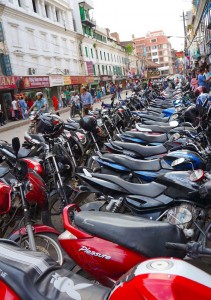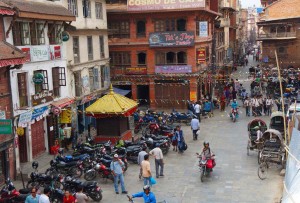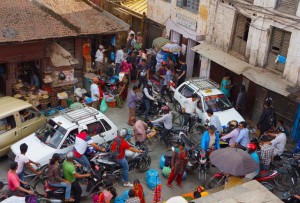
A view from the high ground
I’ve just been out for a bottle of water and walked calmly through a street that doesn’t appear to have any traffic rules, certainly doesn’t have any road markings and yet doesn’t have any real congestion either. Bang in the heart of a populous city, where personal mobility is king and where streets are narrow and road surfaces terrible, vehicles move because the majority of them have two wheels.
This should be no surprise. In Kahtmandu no-one would get anywhere if they all used cars, rather like the M25. To walk down a street and see motorbikes parked two-deep makes my heart soar. Parking is convenient. Helmets are compulsory but only for riders, not any number of passengers, which makes urban travel more convenient. There is no road tax for bikes but then there isn’t really any infrastructure worth maintaining, and of course bikes don’t contribute to the wear and tear on what tarmac surfaces there are.
 Yes it all sounds familiar; bikes are central to ensuring an economy moves and making their use convenient is central to facilitating that. Surely, however, a lawless road traffic system breeds death and misery, especially for vulnerable road users, like riders? Well perhaps the laidback nature of the Nepalese precludes this. In the last two weeks I haven’t seen a single instance of road rage while I’ve been riding through the melêé on an Enfield and I didn’t feel angry or frustrated for a moment. But perhaps relying on the culture of a relaxed national psyche shouldn’t be the central tenet of road safety policy.
Yes it all sounds familiar; bikes are central to ensuring an economy moves and making their use convenient is central to facilitating that. Surely, however, a lawless road traffic system breeds death and misery, especially for vulnerable road users, like riders? Well perhaps the laidback nature of the Nepalese precludes this. In the last two weeks I haven’t seen a single instance of road rage while I’ve been riding through the melêé on an Enfield and I didn’t feel angry or frustrated for a moment. But perhaps relying on the culture of a relaxed national psyche shouldn’t be the central tenet of road safety policy.
You’d think the Nepal Government must have some input to this system and must acknowledge that while they face the infrastructural constraints inherent in any ancient city, they would encourage transportation that already works. This is after all the hallowed ‘free market’ using its hidden hand to find solutions, it is not the work of a well organised motorcycle lobby, funded by industry. But perhaps it’s time it should be.
The Nepal government has started making decisions on urban transport policy. They’ve recently decreed that the front rooms of all buildings on main routes be demolished to make the roads wider to let more cars enter Kathmandu, an idea that appears to be driven by someone’s lobby interest. Buildings are literally having their fronts torn off.
As for powered two-wheelers, it has been decided that there is a terrible issue with fatalities, which can only get worse in the future and must therefore be controlled. The first method being employed is to raise the minimum age of riders (not drivers) and restrict access to bikes. This prevailing attitude that things can only get worse, is insidious. Why must it get worse? Why must studies like that from the BP Koirala Institute of Health Sciences, in Nepal (2005) say that ‘the epidemic’ of road fatalities is only in its infancy?
As a population develops and as an economy improves, it is undoubtedly the case that more vehicles will be registered as they come within the economic reach of more people, but let’s just look at the stats for a minute. A whopping 73% of all vehicles in Nepal are motorcycles and almost all transport is by road. There is one railway but its use is negligible.
 In 2009/10 there were 1,734 road deaths in Nepal according to a report by the UN Economic and Social Commission for Asia and the Pacific (UNESCAP). That’s a terrible number within a population of almost 30 million. But in the UK, with double the population, our fatalities for the same period were 25% higher at 2,222. We have arguably the world’s most advanced health and safety culture and 83% of our registered vehicles are nice safe cars, so let’s just think for a minute. Are motorcycles inherently dangerous?
In 2009/10 there were 1,734 road deaths in Nepal according to a report by the UN Economic and Social Commission for Asia and the Pacific (UNESCAP). That’s a terrible number within a population of almost 30 million. But in the UK, with double the population, our fatalities for the same period were 25% higher at 2,222. We have arguably the world’s most advanced health and safety culture and 83% of our registered vehicles are nice safe cars, so let’s just think for a minute. Are motorcycles inherently dangerous?
Of course not and what’s more, is that where they are in the majority, they are remarkably safe and efficient. I’m not arguing for a minute that Nepal is motorcycling nirvana and I can certainly see the advantage of the occasional traffic light, give way sign or roundabout, but I am frustrated by the refusal of governments everywhere to consider motorcycling in any capacity other than morbidity. I’m a great advocate of rider training and I’m not keen on my own premature death, but clearly motorcycles themselves are not the problem.
 I’m afraid it’s just not good enough to sit back and hope that the vagaries of the British weather will expand or contract motorcycle sales here. It’s time to be proactive and to create the environment necessary to sell bikes. For the good of us all both economically and environmentally.
I’m afraid it’s just not good enough to sit back and hope that the vagaries of the British weather will expand or contract motorcycle sales here. It’s time to be proactive and to create the environment necessary to sell bikes. For the good of us all both economically and environmentally.
If there isn’t a coherent lobby putting the case for two-wheelers, how will we ever achieve the level of convenience, safety and efficiency that bikes can provide and how will we get to enjoy seeing bikes parked two-deep down every high street?
Paddy Tyson



I just want to say that’s a beautiful MZ.